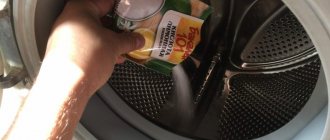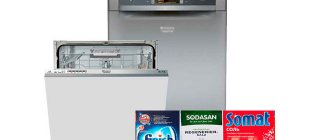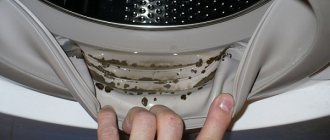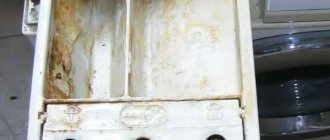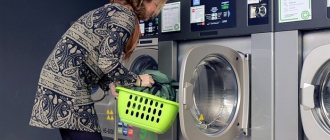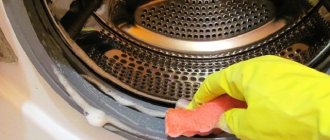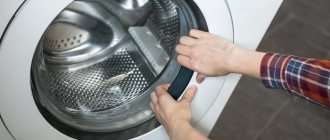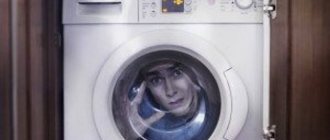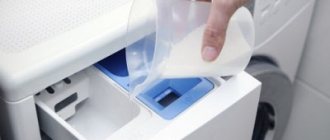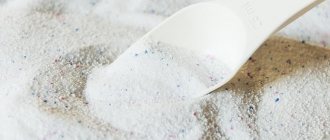Some housewives believe that excess foam in the washing machine drum is a guarantee of impeccably clean laundry.
Manufacturers and service center workers have a different opinion. Intense foaming will not give the expected result, and will also damage the expensive unit.
Therefore, the most important rule for using washing machines is a strict dosage of detergents, regardless of the consistency and form of release.
We will tell you in the article how much powder you need to pour into the washing machine in order to wash your clothes efficiently and not spoil your household appliances.
Factors that influence the cost of funds
To correctly calculate any bulk or liquid product, you must pay attention to the following factors:
Degree of laundry contamination . If the purpose of washing is only to refresh things, the consumption will be minimal. To remove old stains, a larger amount will be required.- Hardness of water . Depending on the indicator, the dose will change up or down.
- Washing machine drum volume There is an average value: for a load of 5 kg in water with average hardness and the usual degree of soiling of the laundry: 150 g of powder, 65 ml of gel or 1 capsule.
- Program. To wash 3 kg of synthetic laundry, you will need half as much powder as to clean cotton with the same weight. This is due to water consumption, information about which can be found in the manufacturer's instructions.
- Type of fabric . Due to their structure, fluffy and porous materials artificially increase the volume of foam. It is better to wash tulle, lace products, down jackets, and overalls with less regular powder or use special products.
Also, consumption depends on what functions the unit has. Washing machines with Eco Bubble technologies, “steam washing”, consume almost half as much powder or gel compared to conventional models.
In machines that independently weigh laundry, the amount of powder is calculated based on the actual weight.
Information about water hardness at your address can be found on the website of the regional company that provides water supply services.
Instructions from the manufacturer
Before purchasing a powder, study its composition. Use some products in reduced quantities or don’t buy them at all.
Detergent for hand washing foams heavily, damaging the internal elements of the washing machine.
- products containing chlorine are famous for their “causticity”, which dissolves rubber fittings. With frequent use, bleach will damage the seals, causing the machine to leak.
Use concentrated substances in small dosages so that they do not change the color of the laundry. Exceeding the norm specified by the manufacturer will provoke molting.
Dosage in grams
Information about the required quantity is placed on the packaging of the detergent . This figure is not always accurate, since it is calculated taking into account the full load of the drum, and is often overestimated.
Experts and experienced housewives recommend using 1 tbsp per 1 kg of laundry. l of powder, that is, 25 g. This is an average figure, it can vary for water with varying degrees of hardness and condition of the laundry.
Dosage of bulk laundry detergents, taking into account water hardness and drum volume:
| Linen weight, kg | Water quality | ||
| Soft | Average | Hard | |
| 1 | 20 | 25 | 30 |
| 3 | 60 | 75 | 90 |
| 4 | 80 | 100 | 120 |
| 5 | 100-130 | 125-150 | 150-180 |
| 6 | 140 | 175 | 210 |
| 7 | 160-180 | 200-225 | 240-280 |
For severe contamination, the dose can be doubled. In order not to increase consumption, it is recommended to treat stains on the fabric with a special product before loading into the drum.
Hardness of water
The developers have determined that water quality has a great influence on the outcome of the wash. In soft stains, like any other contaminants, they are washed off much better, so manufacturers began to add softeners, also called phosphates, to their detergents.
Despite many disputes about their effect on human health, we can say with confidence that in the case of washing equipment they have a positive effect. These salts protect the working parts of the machine from scale, which is especially important when using high temperatures.
Expert opinion
Irina. Housewife.
Ask a Question
As an alternative to chemical softeners, you can use baking soda. You need to add a few tablespoons of the product to the tray with the powder. The only limitation is that baking soda should not be used for wool and silk materials.
At home, hardness can be determined in 2 ways:
- Pour water into a basin and add powder. Foaming can determine the quality of a liquid. If the product does not foam, this indicates increased hardness; if it appears, use soft water.
- Due to scale on the tubular heater of the kettle. In the case of hard water, plaque forms after a month of use, but with soft water, this unpleasant phenomenon occurs no more than once in 6 months.
Measuring the volume of washing powder
Gel volume
Washing gel is a liquid concentrate that contains components that remove dirt , water and fabric softeners. Often, to save liquid, it is used directly in the drum.
It is convenient to measure the required amount of gel; on the packaging the manufacturer indicates the dosage for various modes, and the cap of the container doubles as a measuring cup.
If there are no instructions or a measuring cap, housewives recommend using 1 tbsp per 1 kg of dry laundry. l (15 ml) gel . The dose can be doubled for very dirty laundry.
For hard water, the amount of gel must be increased or a phosphate-based softener must be used.
Where to pour the powder
The detergent container usually has three compartments. The smallest of them is marked with an asterisk or flower. Rinse aid or conditioner is placed in it. The other two are often marked with the numbers I or II and less often with the letters A and B. The first (I or A) is filled with powder in those modes that provide for preliminary washing. The main wash powder is placed in compartment II or B.
Advice
: if the purchased washing machine does not have markings and instructions, then in order to determine where to pour the powder, you need to run the machine for a quick wash and see which compartment the water begins to flow into. This is the main compartment.
It is recommended to pour the thick gel directly into the drum to protect the tray and pipes from blockages.
How many capsules should I use?
Capsule manufacturers have simplified the task for housewives; the product does not require dosage . The soluble casing was filled with the amount of concentrate needed for one wash, provided the drum was fully loaded.
Just place the capsule on the bottom of the drum, load the laundry, select a mode and press the start button. If the degree of soiling of the laundry is high, a double dose may be used.
Tablets and washing plates, which are used similarly to capsules, do not require calculations.
Caring for the washing machine cuvette
In order for the powder receptacle to work properly for a long time, it is necessary to follow a number of recommendations.
After each wash, it is necessary to remove all remnants of washing products (rinse aid, powder), as well as excess moisture, and then dry the cuvette, leaving it open
Periodically, air conditioning must be added to the compartment. After soaking, the cuvette is removed from the niche and then thoroughly washed with a brush.
At the same time, the walls of the hole are also cleaned, where dust and accidentally spilled powder often accumulate.
Consequences of incorrect dosing
Dosing detergents is an important step . Deviations from the norm can negatively affect the laundry and the functioning of the machine.
Exceeding the norm
Excess powder, in addition to streaks on laundry and a strong chemical smell, can cause:
- Problems with the tray. Excess detergent is not completely washed out and settles on the surface. This can lead to the formation of plaque and mold.
- Drain filter clogged.
- An unpleasant odor appears from the drum.
If foam gets on the control board or motor of the washing machine, the owner cannot avoid expensive repairs.
An insufficient amount
If less powder or gel was loaded, the quality of the wash will suffer . The laundry does not wash; undissolved stains can become fixed on the fabric so that it becomes impossible to get rid of them.
Lack of foam and unsatisfactory wash quality are not always a sign of a lack of detergent; the cause may be a breakdown of the heating element. Powder granules dissolve only at temperatures above 40 degrees, so foam does not form in cold water.
Washing technology
When determining the powder dosage, take into account the type of wash. Modern equipment is equipped with innovative technologies that allow you to save powder without compromising the result.
Dry washing involves treating items with steam. The powder is completely dissolved beforehand, so the possibility of soap stains is eliminated. Steam treatment allows you to remove even old and stubborn stains. This eliminates the need to wash and soak items. In addition, such washing significantly saves powder consumption, so much less powder should be added.
EcoBubble technology involves preliminary dissolution of the powder in a foam generator under the influence of supplied bubbles. In this case, washing is performed with a homogeneous soap solution without a single particle of detergent.
Modern technologies - steam treatment and EcoBubble - allow you to save detergent consumption without compromising the quality of washing
When using washing powder, few people worry about how much to put in. You should not pour it intuitively “by eye” or rely on the manufacturer’s recommendations. When choosing a dosage, take into account all the main factors affecting the consumption of detergent.
Advice from professionals
Leading manufacturers have solved the dosage problem by creating a new generation of washing machines with the i-Dos system, which accurately calculates the required amount of powder or gel.
Such units are determined using built-in sensors:
- volume of laundry;
- fabric type;
- degree of pollution;
- hardness of water.
They automatically calculate the dosage of liquid detergent and fabric conditioner, which saves time, effort, reduces the consumption of water and powder, which will have a positive effect on the family budget.
A lot of useful and important information about washing powder is presented in this section of the site.
How to measure using improvised means
Some manufacturers of washing machines equip them with a measuring spoon. However, if you lost a spoon or it simply wasn’t in the machine, you will have to use improvised means. Regular cutlery will do.
See also
Instructions for use of “Whiteness”, composition, characteristics and how to use
A heaped tablespoon holds 25 grams of detergent, a teaspoon holds 5 grams. When filling the washing machine with dry items, take into account their weight, since for every kilogram of items 1 tablespoon of standard detergent or 1 teaspoon of concentrated powder is spent.
